 With start-to-finish domination of their respective men’s and women’s fields, François D’haene (pre-race and post-race interviews) and Andrea Huser (post-race interview) won the Diagonale des Fous, the 167-kilometer (104-mile) race which climbs 9,700 meters (31,800 feet) this weekend on Réunion Island. The day and then some that the lead runners spent traversing the island from roughly south to north brought diversity (and difficulty) of terrain and weather as well as a truly interactive experience with the tens of thousands of island fans who watched and cheered along the course. With this article we attempt to describe the men’s and women’s competitive races and the unique meshing of nature and culture that runners experience courtesy of the race’s popularity on the island.
With start-to-finish domination of their respective men’s and women’s fields, François D’haene (pre-race and post-race interviews) and Andrea Huser (post-race interview) won the Diagonale des Fous, the 167-kilometer (104-mile) race which climbs 9,700 meters (31,800 feet) this weekend on Réunion Island. The day and then some that the lead runners spent traversing the island from roughly south to north brought diversity (and difficulty) of terrain and weather as well as a truly interactive experience with the tens of thousands of island fans who watched and cheered along the course. With this article we attempt to describe the men’s and women’s competitive races and the unique meshing of nature and culture that runners experience courtesy of the race’s popularity on the island.
In addition to this article, you can find a collection of our pre-race interviews and previews on our DdF live-coverage page.
Ps. To get all the latest ultra news from iRunFar.com, subscribe via RSS or email.
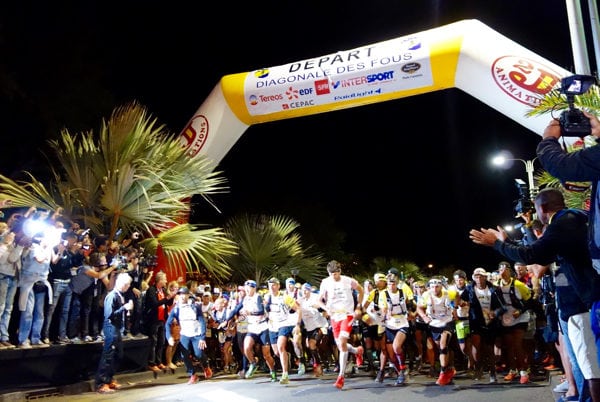
The start of the 2016 Diagonale des Fous on Réunion Island. Photo: iRunFar/Meghan Hicks
2016 Diagonale des Fous Race Setting
We’re starting this results article off a bit differently than usual because, well, the Diagonale des Fous is a different event. Additionally, since this is the first time iRunFar has covered the event and not a lot is known about it in the English-speaking trail world, we thought a baseline description of the race might be beneficial.
The Diagonale des Fous was first run in 1989, and so the now 850,000 inhabitants of Réunion Island have had two-and-a-half decades to develop a relationship with the race. And what a relationship they have! The term ‘crazy’ is often applied to the race, and that’s a great basic description of fans’ excitement about the race. We heard estimates that some 20,000 people were predicted to watch the start and that 10% of the population would physically watch the race from somewhere on the course. And local radio and TV stations offered nonstop race coverage for days, so many more followed remotely. I would sincerely be surprised to meet an islander who hasn’t heard of the race. DdF has become one of the island’s main annual events and it captures everyone’s attention. [Editor’s Note: You can learn more about the race’s long history and its place in Réunion Island culture with this essay.]
Many DdF fans behave like trail running fans I’ve seen around the world, but there’s a good deal of ‘freneticism,’ too, though that’s almost entirely focused on the lead couple men. Though I can’t say for certain, it’s an educated guess based on observing the movements of other media that this is a result of local media focusing mostly on the lead couple men. I would venture a guess that, further back in the pack, and even with the top women, fans are still quite interactive in cheering for runners, but less wildly so. What do I mean by frenetic? Smashing beer bottles in excitement at the start. Jogging behind the leaders for some distances. Creating a funnel of fans with hands reaching in to touch a runner as they pass.
The starting line in Saint-Pierre, a large city on the southwest part of the island, is a true spectacle. The race organization presents a festival-like environment for non-participating islanders to come out and enjoy themselves. A concert of rotating local bands begins four hours before the race start. Circus-type performers rove the crowd. People sell glow sticks, glow necklaces, glow pinwheel thingys, and noisemakers from rolling carts. Others sell beer, water, and soda, and there are food trucks offering all sorts of food. At first the atmosphere is chill, with a core group of people in front of the concert stage dancing and partying. But starting about 90 minutes before the race, excitement mounts and people swarm, looking to get a view of the 50 or so top runners who are funneled into an ‘elite’ area and to get a viewing spot for the race start.

The 2016 Diagonale des Fous starting-line party. Photo: iRunFar/Meghan Hicks
The 2,500 or so runners are blocked off from the public into their own area. It’s not huge, but big enough for anyone who wants to sit or lay down to do so. It has one row of portapotties, but I was told that people urinate freely all over the participant area. There are also some tents offering drink and food for participants. This was by far the most solemn part of the start area–the runners largely lay about quietly, conserving energy.
About 30 minutes from the start, the organization funnels participants into a street-wide chute connecting the 400 meters or so between the runner waiting area and the actual starting line. The energy of the five minutes it takes to do this is nuts. A line of volunteers links arms and strings themselves in front of the mass of runners to prevent a mad rush toward the start line (And possibly beyond? One year there was a false start when a loud noise made some jittery runners run off and everyone followed. There was no restart–that was the actual race start that year.) American runner Joel Meredith described these few moments as chaotic with people sprinting to get an up-front starting place.
Once the runners are in place, it’s still a long wait until the actual start, 25 minutes or so. You see all kinds of behavior during this time: everything from runners and fans standing quiet and observing, to other fans leaning into the starting chute trying to get a photo of or an autograph from a runner, to fans and runners dancing and singing. By the time the race starts, the announcers and music have worked everyone but a few runners into excitement mode. Loud and wild is the actual start. The course runs several kilometers on pavement before hitting the trails, and I was told that all of this pavement is a giant fan funnel.
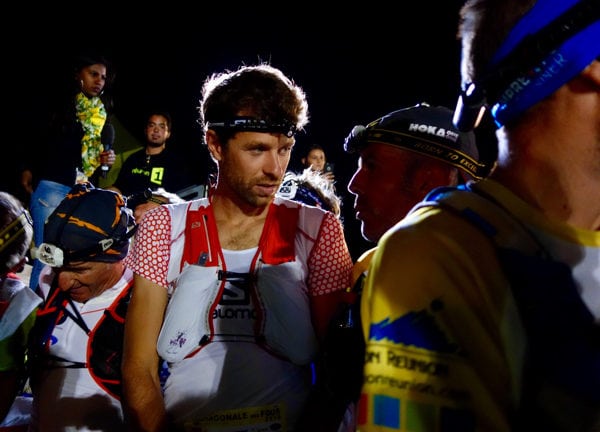
François D’haene and Patrick Bohard share a quiet moment among the 2016 Diagonale des Fous starting-line frenetics. François went on to win and Patrick finished seventh. Photo: iRunFar/Meghan Hicks
The course delivers every kind of terrain. There are kilometers of pavement connecting the route into and out of towns and villages. There’s developed singletrack in the national park that makes up the core of the island. There are dirt roads and pathways through private agricultural fields–a lot of sugar-cane fields and grazing grounds for cattle–cut just for the race.
At the core of the race course is the Cirque de Mafate, a giant and road-less volcanic caldera that runners drop into at about 75 kilometers and climb out of at 115 kilometers. This section of the race is visually stunning. Everywhere, all the time, is an insane view. Many people recreate on the trails of Mafate, which were first made more than 200 years ago to help slaves flee from their enslaved coastal lives and hide in the cirque. Also, there are several villages where locals live year round in the cirque–maybe 50 to 100 dwellers in each of the villages.

Scenery inside the Cirque de Mafate, part of the Diagonale des Fous course. Photo: iRunFar/Meghan Hicks
When you travel through Mafate during the race, you’re traveling through a ridiculous natural spectacle, the home of several hundred people, and a place where both locals and tourists recreate (and come out to cheer the race). In most races, when you travel through a place as remote and inaccessible as Mafate is, you’d be all by yourself for kilometers at a time. In DdF, you are constantly surrounded by people. A few runners described seeing people every few minutes to every few seconds, at times.

The young ladies of Roche Plate, a roadless village in the Cirque de Mafate located at 109 kilometers into the Diagonales des Fous. Photo: iRunFar/Meghan Hicks
Unfortunately, with all these people came trash–produced by both runners and those observing the race. In my mind, there is no excuse for littering, period, let alone in a national park, let alone during a trail race. Respect of nature should be a core value in this situation. The main issue I observed is toilet paper, but runners I talked to also spoke about significant litter from food wrappers. I hope the race organization chooses to address this problem.
Built stairs and rocks that require the stair-climbing or stair-descending motion seem like the dominant terrain. The trails do, in fact, have switchbacks, but the switchbacks are still super steep. This year, the course was dry and dusty in places, but Gediminas Grinius said that one year it was quite muddy. While the course seems to always be trending toward ascending or descending, it’s never just doing one or the other. On a long ascent for example, say 800 meters, there will be some significant descent snuck in there. Several runners said that you can’t find a rhythm because of these constant changes. “Unceasing technicality” and “the most technical terrain I’ve ever seen” are two summaries I heard about the course.
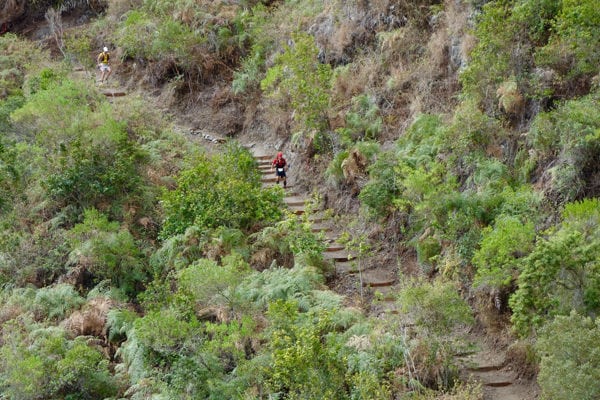
Runners on the endless stairs of the DdF course. Photo: iRunFar/Meghan Hicks
Helicopter use is a reality on Réunion Island. With such steep and undulating terrain, helicopters help make life happen here. It’s how supplies are shipped into and refuse out of the villages of Mafate, for example. As such, helicopters are wildly used during the race for media–and the helicopters absolutely hound the runners, getting incredibly close to the runners and the ground. If you’re in the top 10 or so, you will be followed closely by helicopters for several daylight hours in total. I’ve seen helicopters at a lot of European races, but never anything like what I saw at DdF.
The finish line takes place in a stadium on the edge of Saint-Denis, the island’s biggest city located in the north of the island. Again the carnival-type atmosphere is developed during the days that the racers of the DdF and the two, smaller sister races are finishing. There’s a beer tent, a food tent, booths and shops, a climbing wall, and more. Locals bring lawn chairs, blankets, and coolers, and come and relax for a couple hours at time, likely to wait for a friend or family member to finish. However, the atmosphere is much more calm and with far fewer people than at the start. When the top couple men finish, there are perhaps 1,500 or 2,000 fans in and just outside the stadium. Kind of funny to say there are that many fans on hand for a trail race and yet it had a ‘calmer’ feeling than the start. It’s still a huge party! Second place this year was 10-time DdF finisher Antoine Guillon, who was also last year’s race winner. He’s quite popular with islanders. So, there was a lot of energy for the second-place finisher, too, but far fewer people watching even though he arrived only a half hour later.
And then… it got scarily quiet. Crowds gathered briefly again to see Andrea Huser win the women’s race, but probably 25% of the number who were there to see François D’haene win the men’s race. By the time Emma Roca finished in third place, the stadium was absolutely deserted.
In all, it was a wild experience to witness and I’m guessing an even wilder experience in which to participate.
2016 Diagonale des Fous Men’s Race
France’s François D’haene (pre-race and post-race interviews) was, quite simply, in his own class… for 146 kilometers. For the race’s first 30 kilometers or so, François ran among the lead men before emerging alone at the front at kilometer 35, with no one else within five minutes. He built a lead from there, slowly and surely, until Maïdo at 115k where he was 80 minutes ahead of everyone in the men’s field. On whatever sort of terrain we saw him, he looked calm and in total control. Even when TV cameras chased and helicopters blew debris on him, his composure was rock steady.

François D’haene at 29 kilometers into the DdF. Photo: iRunFar/Meghan Hicks
But as if in prediction of his own future, when asked how he was feeling at 97k, he answered that he felt good but that it was a long way still. When we saw him next at 109k, in the middle of a 2,000-meter climb during the heat of the afternoon, he looked ever so ‘touched’ by the conditions. He sat for several minutes to rest and rehydrate, which seemed to reinvigorate him, and he took off uphill looking really well. To the media in Maïdo at 115k and despite his lead, he admitted that he was feeling tired. François was able to maintain his large lead from there to the town of Possession at 146k. When he ran into town there, while being cheered for by hundreds of fans, you could see he was straining. From there over the next half-marathon distance to the finish, he gave up 50 minutes of his lead. But there was too little real estate left and he had too big of a buffer–François was just too strong–and so he crossed the line as the 2016 Diagonale des Fous champion. He adds this to wins here in 2013 and 2014.

François D’haene, 2016 Diagonale des Fous champion. Photo: iRunFar/Meghan Hicks
It’s safe to say that France’s Antoine Guillon (pre-race and post-race interviews) loves Réunion Island and Réunion Island loves him. Antoine started the 2016 edition as the defending champion and with nine previous finishes, what might amount for some people to a lot of pressure. If Antoine felt any pressure, it was never visible. He’s the kind of guy you’d want around if there was an emergency–calm and able to stay the course no matter what. Fans on the course referred to him as the ‘metronome,’ and this descriptor is so on point! His splits between last year and this year were often within a couple minutes, and his finish time this year was two minutes and a few seconds faster than in 2015. For the race’s first 68k, Antoine ran within the men’s top 10. After that, there’s a gnarly climb to a col. It was in this section that Antoine propelled himself into second position, where he would almost exclusively stay until the finish. Likely a result of his DdF experience and his methodical approach to racing in general, Antoine maintained a strong pace all the way, closing hard on François ahead of him and maintaining the gap between he and third place.
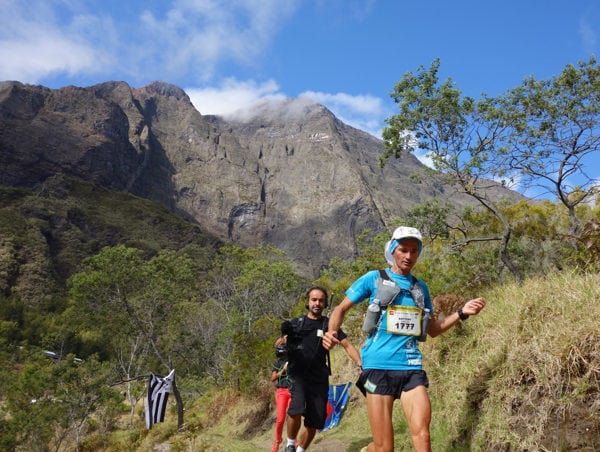
Antoine Guillon on his way to second place and his 10th DdF finish at Marla, 80 kilometers into the race. Photo: iRunFar/Meghan Hicks
It’s a little scary how easy Spain’s Javi Dominguez (post-race interview) made running DdF look. Like Antoine, Javi took things out more conservatively, arriving to the first checkpoint at 15k a few positions outside of the top 10. In the honest uphill from there, however, Javi moved himself up an equally honest number of positions to the edge of the top-five men. By the time he dropped into the Cirque de Mafate at 80k, he was in third position, where he would stay for the entire second half of the race. For the next 50k, however–Javi would later say he had no idea what was happening in the race behind him–he had a string of men breathing down his neck. Finally, at the town of Possession at 146k, Javi maintained his pace while the men behind him slowed ever so much that he increased his gap to fourth place. That said, over the race’s final 21k, the gap between he and second-place Antoine stayed about the same as they progressed separately but at about the same rate. After finishing fifth here in 2014, Javi hit it big this time with a podium finish.
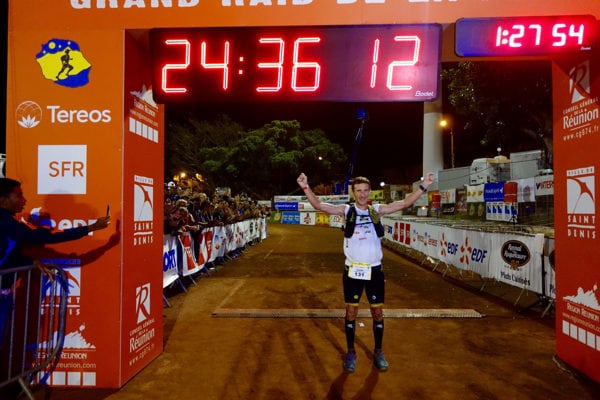
Javi Dominguez is elated with third place. Photo: iRunFar/Meghan Hicks
South Africa’s Ryan Sandes is back. I knew it was going to happen, but just didn’t know when. And to be 100% honest, I wasn’t sure that it would be at this race because he and his wife, Vanessa, just had their first child a few weeks ago–an awesome undertaking. Ryan had a huge 2014, performance-wise, and then he struggled with his health in 2015. And, it seems that the early part of 2016 was about getting his performance back to world-class level. Ryan went out a bit faster than we’ve seen him in other competitive 100 milers, running inside the top 10 straight away. Ryan and France’s Maxime Cazajous crossed the line together to tie for fourth place. Maxime finished 14th and over 28 hours in 2015 and he returned to better his position by 10 spots and his time by three hours–an incredible improvement.

Gediminas Grinius didn’t finish DdF due to several physical issues, but he wins the 2016 Ultra-Trail World Tour. Photo: iRunFar/Meghan Hicks
2016 Diagonale des Fous Men’s Results
- 1. François D’haene (Salomon) – 23:44:57 (pre-race and post-race interviews)
- 2. Antoine Guillon (Raidlight) – 24:15:22 (pre-race and post-race interviews)
- 3. Javi Dominguez (Vibram) – 24:36:24 (post-race interview)
- T-4. Ryan Sandes (Salomon) – 25:23:31
- T-4. Maxime Cazajous (Compressport) – 25:23:31
- 6. Erik Clavery (adidas) – 26:06:54
- T-7. Patrick Bohard (Hoka One One) – 26:18:19
- T-7. Sylvain Camus (Garmin) – 26:18:19
- 9. Marco Zanchi (Vibram) – 27:14:13
- 10. Francesco Cucco – 27:41:17
2016 Diagonale des Fous Women’s Race
Did you enjoy the Andrea Huser (Switzerland) (post-race interview) show? Because it was a good one. For the race’s first 15k, Andrea let other women take things out hot, and she arrived to the 15k checkpoint in fourth place. However, in the next 20k, she worked her way through the rankings and into first position by the time we next saw her at 29k. When asked how it was going at this point in the race, her answer was alarmingly casual. Was there even a race going on, at least in her head? It was hard to tell! Boom, boom, boom, at every aid station for the next 90k, she looked fresh and like she was hardly even sweating. And yet, she was decidedly putting time on the rest of the women’s field and, let’s just be honest, the men’s, too. In those 90 kilometers, she went from 54th position to 14th position in the general ranking.
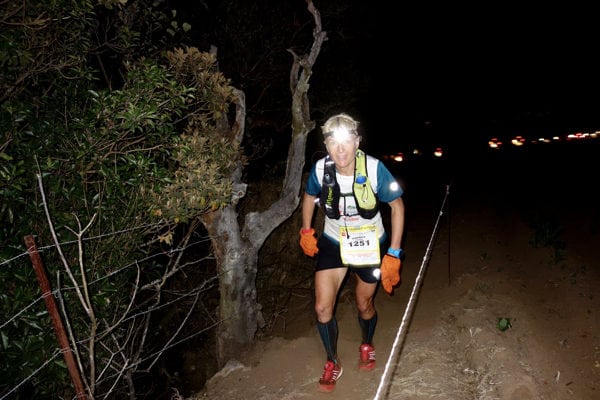
Andrea Huser climbing at 29 kilometers into DdF. Photo: iRunFar/Meghan Hicks
At Roche Plate, located at 109k and halfway up the 2,000-meter climb to Maïdo at 115k, a member of the media asked her if she thought she would win. She laughed as if it was a silly question, perhaps not because she thought it was a sure thing, but because the idea of winning was clearly the farthest thought from her mind at this point. Like nearly all of the runners at this point, she said she was tired and she looked warm in the midday heat. That said, I saw her working it on the balance of the climb from there, and she was moving just fine. She would say after the race that it was the part of the climb above Roche Plate in which she felt the most tired. Impressive, then, that she was moving as well as she was there. Andrea has been on fire with her 2016 season, and here at DdF, she improves on last year’s third-place finish by two places and an hour.

Andrea Huser, 2016 Diagonale des Fous champion. Photo: iRunFar/Meghan Hicks
France’s Juliette Blanchet (post-race interview) has a chill presence when she races. Quiet and focused, but not edgy. A bit like Javi Dominguez on the men’s side, and such a presence makes running to second place at DdF look far easier than I know it must be. Juliette started the race conservatively, arriving to the first checkpoint, Domaine Vidot at 15k, in about 150th position in the general ranking. She would say later that she doesn’t run as fast as other runners early in races, so she relies on being able to maintain the same effort through a whole event. By 29k, she’d worked her way to sixth position for the women, but was still outside the top-100 overall. And, then, by 51k, she had moved up to second place where she would remain for the rest of the race. While she would stay distant from race winner Andrea Huser, she built a solid cushion over the rest of the women’s field. Two years ago here, Juliette finished second in a late-race sprint with Uxue Fraile. This time, with no other women near, Juliette could take things in and enjoy her second second-place finish.

Juliette Blanchet looks chill at Roche Plate, 109 kilometers into DdF, on her way to a second-place finish. Photo: iRunFar/Meghan Hicks
For Spain’s Emma Roca (pre-race and post-race interviews), this race did not come easy. But in talking with Emma pre-race, it was clear she was expecting to be challenged by the course, the heat, and adjusting to the zero-drop Altra shoes she’s been running in for the last three months. It seems she had prepared in advance for an eventuality of fighting for her finish. Emma’s one of the toughest women I know, and to see how hobbled she was after the race–that’s when you know a race is a challenging one. After shifting around positions in the race’s first marathon, Emma settled into third place where she would stay for 120-some-odd more kilometers. Emma would explain after the race that she tried to push the downhill after 115k to make a bid for second place. But she said she just didn’t have it in her body, so she eventually crossed the line in third, a strong first showing at DdF.
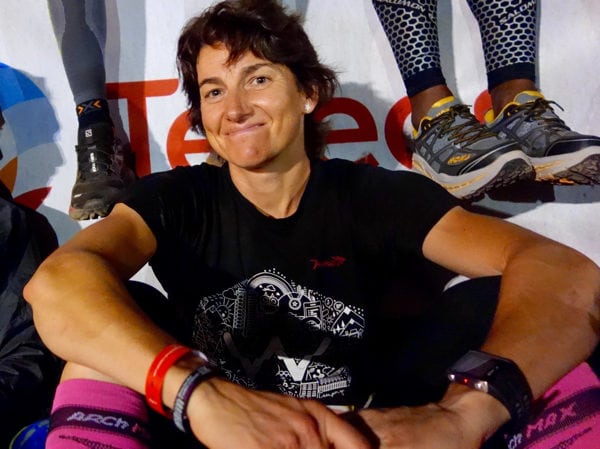
Emma Roca stays calm amidst pre-race insanity before the start of the 2016 DdF. She went on to finish third. Photo: iRunFar/Meghan Hicks
After leapfrogging with each other several times in the race’s second half, France’s Mélanie Rousset and Jocelyne Pauly crossed the finish line together in a tie for fourth place.
2016 Diagonale des Fous Women’s Results
- 1. Andrea Huser (Mammut) – 27:44:13 (post-race interview)
- 2. Juliette Blanchet (Isostar) – 29:26:07 (post-race interview)
- 3. Emma Roca (Altra) – 30:10:53 (pre-race and post-race interviews)
- T-4. Mélanie Rousset – 32:44:09
- T-4. Jocelyne Pauly (WAA) – 32:44:09
- 6. Alexandra Clain (Decathlon) – 33:40:04 (pre-race interview)
- 7. Elisabeth Legros – 34:34:17 (pre-race interview)
- 8. Sylvie Negro – 34:57:15 (pre-race interview)
- 9. Lucie Croissant – 34:59:29 (pre-race interview)
- 10. Nadine Leveneur – 36:17:54 (pre-race interview)
Thank You
First, thank you to Mauri Pagliacci for his office assistance during the race. iRunFar received an incredibly warm welcome by a large group of trail running fans on Réunion Island looking to help bring the race story to an audience beyond the island. Thank you to the massive team on the island who helped us cover the race: Fabrice Payet, Lukas Garcia, Teddy Loricourt, Gaël Archier, Anne-Julie Payet, Ludovic Mercher, Vincent Carpier, Léo Rogaume, Vivien Dubois, Raphaël Antier, Thierry Nicolaï, Arnaud Blanc, Amyas Boithias, Renaud Flamain, Reno Fouquesolle, and Pierre Bellet. Wow, wow, wow, merci beaucoup!
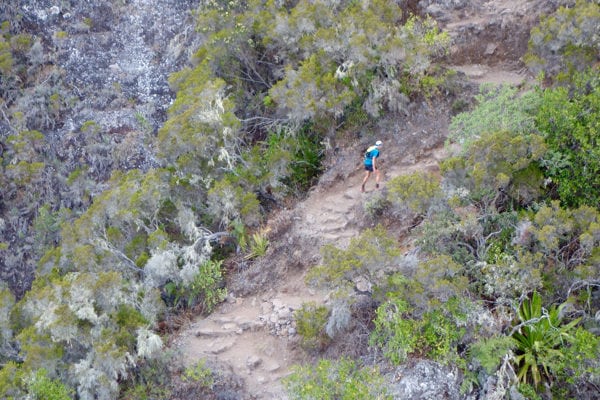
Andrea Huser on the 2,000-meter climb leading to Maïdo at 115 kilometers into DdF. Photo: iRunFar/Meghan Hicks
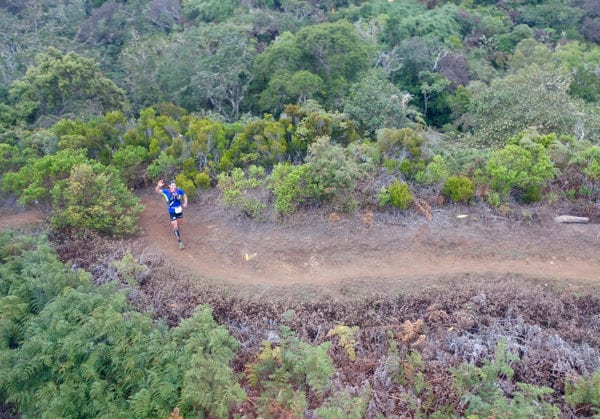
Fourth place Maxime Cazajous looks happy as he runs during the 2016 DdF. Photo: iRunFar/Meghan Hicks
